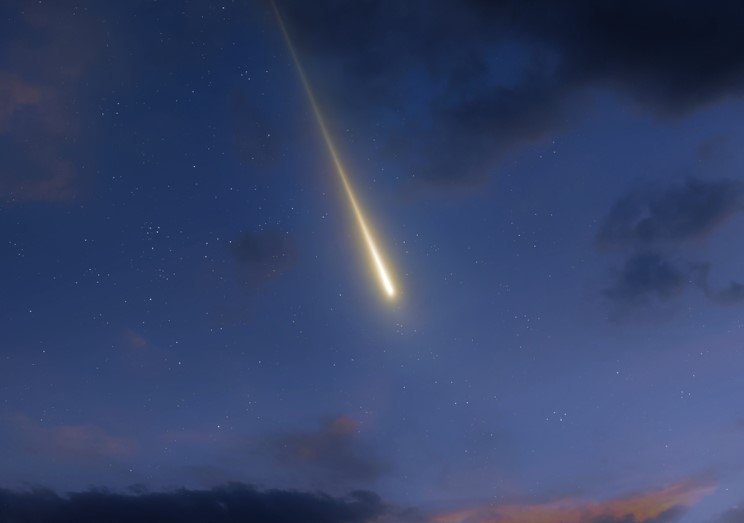A quiet summer afternoon in Georgia turned extraordinary when a meteorite crashed through a family’s home. Now, scientists say the rock is a relic from before our planet was even born.
A Rock from the Dawn of the Solar System
When something from the sky smashes through your roof, you don’t expect it to rewrite history books. But that’s exactly what happened in McDonough, Georgia, on June 26.
The space rock, roughly the size of a cherry tomato, came in hot — literally — tearing through the atmosphere at bullet-like speed before exploding with a series of sonic booms. Witnesses described a sharp crack in the sky, followed by rattling windows and a rush of startled shouts.
For the homeowner, the moment was surreal. One second, a quiet living room. The next, a smoking dent in the floor — and a hole in the ceiling where the intruder had arrived.
The Science That Stopped Researchers in Their Tracks
University of Georgia planetary geologist Scott Harris knew the meteorite was special before he even put it under a microscope. But the age he discovered still floored him: 4.56 billion years.
That’s around 20 million years older than Earth itself. In cosmic terms, it’s like finding a fossil from before dinosaurs existed — except the “fossil” predates the very ground we walk on.

Harris examined just 23 grams of the meteorite. Even that tiny sample told a story stretching back to the earliest days of the solar system, when dust and gas began clumping together into planets, moons, and asteroids.
“This meteor had a very, very long journey before it ended up here,” Harris said. “Double the size of a .50-caliber shell, moving at least a kilometer per second — you can imagine the force.”
What Witnesses Saw and Heard
Not everyone spotted the rock itself, but plenty saw the fireball streaking across the Georgia sky. Some described a bright white flash, others a flicker of orange before it broke apart.
Then came the sound. First the boom, then a shockwave that rattled homes for miles. One McDonough resident said it felt “like someone slammed a heavy door upstairs,” except louder and deeper.
Others were outside, looking up in disbelief as the streak faded. A few even caught it on video, and by evening, clips were making the rounds online — proof that the strange noise earlier hadn’t been thunder.
How Scientists Date Something Older Than Our Planet
Determining the meteorite’s age wasn’t just about looking at it. Harris and his team used isotopic analysis, measuring radioactive elements that decay at predictable rates.
In simple terms: certain elements inside the meteor have been breaking down into other elements for billions of years. By calculating how much of the original remains versus what it’s turned into, scientists can rewind the clock.
Here’s a snapshot of what the analysis suggested:
| Measurement Type | Approximate Age | Significance |
|---|---|---|
| Radiometric Dating (Uranium-Lead) | 4.56 billion years | Formation in early solar system |
| Mineral Structure Study | Matches ancient chondrites | Confirms non-Earth origin |
| Chemical Composition | Low volatile content | Indicates exposure to space for eons |
The numbers lined up with meteorites known as chondrites — rocky fragments left over from the solar system’s earliest building blocks.
The Odds of It Landing Where It Did
Meteorites hit Earth more often than most people think, but the odds of one punching through a specific roof? Incredibly slim.
Experts say most meteors burn up in the atmosphere or fall into oceans, forests, or deserts where no one notices. A space rock landing in a suburb, in broad daylight, and getting recovered intact is rare enough to excite scientists worldwide.
The fact that this one is older than our planet makes it even more of a scientific jackpot.
-
Meteorites fall daily, but most are too small to survive the atmosphere.
-
Large recoveries in populated areas happen only a few times a year globally.
-
Chondrites make up about 85% of meteorite finds, but very few are this well-preserved.
What Happens to It Now
The homeowner didn’t just get a new ceiling repair — they now have one of the oldest physical objects on Earth sitting in a lab. Harris says the University of Georgia will continue studying it, potentially lending samples to other institutions.
Pieces of meteorites like this often end up in museums, private collections, or research archives. In this case, scientists are hoping to learn more about the early solar system, including how planets like ours formed.
For now, the homeowner is adjusting to the idea that their house was part of a cosmic event. As one neighbor put it, “You just don’t expect the universe to drop by unannounced.”
Why This Discovery Matters
Sure, it’s just a rock — but it’s a rock from before the Earth existed. That kind of perspective can be hard to grasp. This meteorite is a time capsule, frozen since the first swirling clouds of gas and dust began shaping the planets.
Studying it could reveal clues about the materials that went into building our world. It’s like holding a fragment of the recipe for Earth — only baked 20 million years early.
And it’s a reminder that while we often think of space as distant, sometimes it shows up right in our living rooms.
